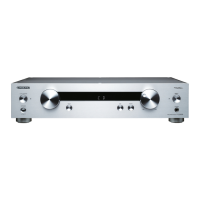6
En
Technologies
DIDRC (Dynamic Intermodulation
Distortion Reduction Circuitry)
Since the advent of digital audio, the values of
S/N (signal-to-noise) ratio have risen
significantly. However, it is also recognized that
in terms of perceived S/N, analog audio sources
are not inferior to digital sources.
Generally, S/N measures the ratio when sound
is and not produced, but takes no account of the
noise generated during sound reproduction.
For a long time, Onkyo has focused and made
extensive research on the S/N when sound is
produced (dynamic S/N). Using a mechanism
that captures the noise beyond audible range, it
has been possible to determine that both
dynamic S/N and perceived S/N aggravate
during music reproduction.
Although frequencies above 20 kHz are beyond
human hearing, it is well known that a beat can
be perceived if different signals are overlapped
at such frequencies.
During the analog audio era, no significant
signals were entering beyond the audible range.
However, the digital era has made recording
beyond the audible range possible and the
generated beat is now perceivable.
With Onkyo’s DIDRC technology, a new
approach is introduced which prevents such
beat from penetrating the audible range.
Separate Digital/Analog Circuitry and
Transformers
To prevent unwanted interference, the P-3000R
employs physically separate circuitry for digital
and analog processing. What’s more, it also
features separate transformers for digital and
analog circuitry.
Playback of Various Music Sources Including
PC Audio via USB
Using the USB port on the rear panel of the
P-3000R, you can connect your PC and play
back 192 kHz/32-bit HD audio formats
*
.
*
Playback of PC audio requires dedicated software
that can be downloaded from an Onkyo website.
PLL (Phase Locked Loop) Ultra-Low Jitter
Technology
Jitter is an unwanted side-effect of the digital-
to-analog conversion process caused by
fluctuations in the time domain of a digital
signal. PLL ultra-low jitter technology reduces
jitter by comparing the input and output phases
of the digital signal and creating an accurate
clock waveform. This enhances the precision of
digital signal processing and noticeably
improves perceived audio quality.
Side-mounted Circuit Board Construction
Rather than being directly connected to the
chassis base, the circuit boards inside the
P-3000R are cushioned by internal struts and
affixed to the front, side, and rear panels. This
method of construction prevents vibrations
from the chassis from adversely affecting the
circuit boards.

